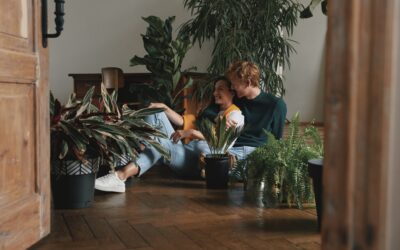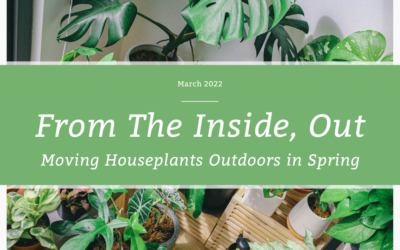If you are living in an apartment, home, or dorm room that does not receive much natural sunlight, it can be hard to keep certain sun-loving houseplants alive. However, there are many low-light loving houseplants that will allow you to still enjoy beautiful greenery in your home.
The plants that are listed below still need some sort of light source despite them being able to thrive in lower lighting conditions. If you are looking to place a plant in a room with no windows or natural lighting, you may want to consider the help of a grow light. Grow lights mimic the sun’s rays in a way that typical household bulbs are not capable of. They come in all shapes and sizes, or even as bulbs you can use in any lighting fixture.
Pothos:
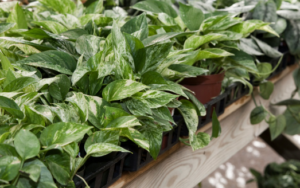 Pothos, also called Devil’s Ivy, are an extremely popular and easy-to-care for trailing houseplant. They are fairly drought tolerant, making them great for beginner houseplant lovers. It is a beautiful, durable, and easy-to-grow vining houseplant with smooth heart shaped leaves that come in a variety of different colors. From shades of green to gold to white, there are an endless amount of choices when it comes to Pothos varieties. They thrive best when they have bright, indirect light, but they will thrive in lower lighting conditions. It is best to let pothos’ soil dry out between waterings to prevent root rot. If you have pets at home, this plant is considered toxic to them.
Pothos, also called Devil’s Ivy, are an extremely popular and easy-to-care for trailing houseplant. They are fairly drought tolerant, making them great for beginner houseplant lovers. It is a beautiful, durable, and easy-to-grow vining houseplant with smooth heart shaped leaves that come in a variety of different colors. From shades of green to gold to white, there are an endless amount of choices when it comes to Pothos varieties. They thrive best when they have bright, indirect light, but they will thrive in lower lighting conditions. It is best to let pothos’ soil dry out between waterings to prevent root rot. If you have pets at home, this plant is considered toxic to them.
Light: bright indirect to low light
Water: water thoroughly when top 1”-2” of soil is dry to the touch
Snake Plant (Sansevieria):
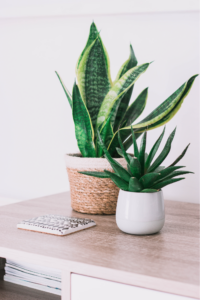 Sansevieria varieties are some of the best options for low light loving houseplants. You often see them in shopping centers and malls that do not have a ton of natural lighting throughout their building. Snake plants come in many shapes and sizes. Sansevieria Laurentii is tall and slender with yellow edges and a green striped center. Sansevieria Moonlight is also tall and slender, but with a light mint green and silvery coloring. Sansevieria Starfish, Cylindrica, and Samurai are all more short and compact varieties with spikier looking stems.
Sansevieria varieties are some of the best options for low light loving houseplants. You often see them in shopping centers and malls that do not have a ton of natural lighting throughout their building. Snake plants come in many shapes and sizes. Sansevieria Laurentii is tall and slender with yellow edges and a green striped center. Sansevieria Moonlight is also tall and slender, but with a light mint green and silvery coloring. Sansevieria Starfish, Cylindrica, and Samurai are all more short and compact varieties with spikier looking stems.
It is best to avoid overwatering Sansevierias as they can be prone to root rot if exposed to excess water around their roots for long periods. Let these plants completely dry out between waterings to avoid this issue. They are fairly drought tolerant and actually prefer to stay a bit on the dryer side between waterings. It is important to note that this plant is toxic to pets.
Light: bright, indirect to shade
Water: let top 2” of soil dry between waterings
Moonshine Sansevieria – Houseplant of the Week – YouTube
Peace Lily (Spathiphylum):
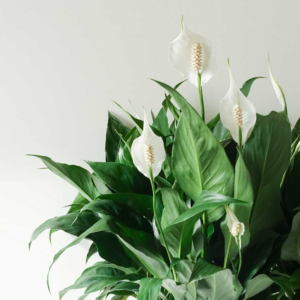 Peace Lilies are popular for their beautiful white blooms that they produce year round and for their ability to be relatively low maintenance. Peace Lily varieties typically have dark green foliage with white to pale yellow blooms, but a few varieties, including the Spathiphyllum Domino, have white variegation on the leaves giving you plenty of options to choose from.
Peace Lilies are popular for their beautiful white blooms that they produce year round and for their ability to be relatively low maintenance. Peace Lily varieties typically have dark green foliage with white to pale yellow blooms, but a few varieties, including the Spathiphyllum Domino, have white variegation on the leaves giving you plenty of options to choose from.
These plants do best in bright, indirect light, but will still do well in shadier locations. They enjoy an evenly moist soil, never wanting to completely dry out. If your Peace Lily begins to wilt, this is typically a sign that it needs to be watered. Even though they like their soil to stay moist, they are not immune to root rot, so waiting for your plant’s top inch of soil to dry out before watering each time is a good way to avoid this. This plant is also toxic to humans and pets if consumed.
Light: bright, indirect to shade
Water: evenly moist; let top 1” of soil dry between waterings
Peace Lily – Houseplant of the Week – YouTube
ZZ Plant (Zamioculcas Zamiifolia):
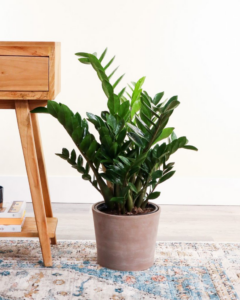 ZZ plants, much like Sansevierias, are often found indoors in malls and shopping centers, because they are very tolerant of lower lighting conditions. These plants are super tough and are perfect if you are a houseplant lover that maybe tends to forget about watering. ZZ plants thrive in any lighting condition except for direct sunlight. These plants come in dark green and even a shade that closely resembles black. This dark colored variety is known as the ZZ Raven, which is currently super trendy and popular.
ZZ plants, much like Sansevierias, are often found indoors in malls and shopping centers, because they are very tolerant of lower lighting conditions. These plants are super tough and are perfect if you are a houseplant lover that maybe tends to forget about watering. ZZ plants thrive in any lighting condition except for direct sunlight. These plants come in dark green and even a shade that closely resembles black. This dark colored variety is known as the ZZ Raven, which is currently super trendy and popular.
Not only does this plant do well in low light conditions, it is also very drought tolerant. If you are someone that is always on the go, and does not have time to water your houseplants consistently, the ZZ plant is going to be your new best friend. They actually prefer to dry out completely between waterings, because they have thick rhizomes that store water for them. This means that this plant is prone to root rot, so make sure you are waiting to water your ZZ plants until the top two to three inches of soil is dry. Keep ZZ plants away from children and pets, as they are toxic when eaten.
Light: bright, indirect to shade
Water: water when the top 2”-3” of soil is completely dry
Raven ZZ Plant – Houseplant of the Week – YouTube
Lucky Bamboo (Dracaena Sanderiana):
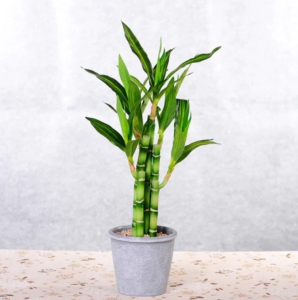 Lucky Bamboo is another great low light houseplant option that can be found in many offices, homes, and even restaurants. A fun fact about these plants is that they are said to bring good luck, especially when received as a gift.
Lucky Bamboo is another great low light houseplant option that can be found in many offices, homes, and even restaurants. A fun fact about these plants is that they are said to bring good luck, especially when received as a gift.
The Lucky Bamboo plant can grow in lighting conditions from bright, indirect all the way to more shady locations. They can also easily be grown in water or soil, making them great for propagation walls and more. If growing this plant in soil, make sure to water regularly to keep the soil evenly moist. This plant does enjoy higher humidity levels, so locating it somewhere in your home that gets high humidity, such as a bathroom, is ideal. Most bathrooms have minimal natural lighting, which makes it another great option for this particular room in your home. This plant is considered to have toxic properties if consumed.
Light: bright, indirect to shade
Water: regularly, or when top 1” of soil is dry to the touch
Cast Iron Plant (Aspidistra Elatior):
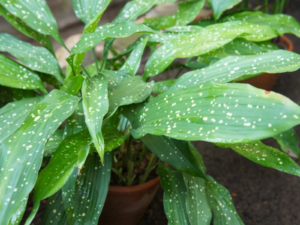 Cast Iron plants have received their name from their reputation of being nearly indestructible. They are able to withstand very low light conditions and minimal watering. This plant comes in several varieties including those with green leaves, leaves with pale yellow spots decorating them (pictured), and leaves featuring pale yellow striping.
Cast Iron plants have received their name from their reputation of being nearly indestructible. They are able to withstand very low light conditions and minimal watering. This plant comes in several varieties including those with green leaves, leaves with pale yellow spots decorating them (pictured), and leaves featuring pale yellow striping.
Even though these plants can thrive under conditions of neglect, they prefer to have no direct sunlight and to be watered when the top inch of soil is dry. Direct sunlight will quickly burn the leaves of the Cast Iron plant, so keep them in shadier areas. They are very forgiving when it comes to forgetting to water them, however, they would prefer their soil to be consistently moist. This plant is non-toxic if consumed.
Light: indirect to shade
Water: soak when top 1” of soil is dry
Cast Iron Plant – Houseplant of the Week – YouTube
These are just a few options in terms of houseplants that will thrive in low light environments. If you are someone who is a houseplant lover but has minimal light in your home, these are going to be wonderful options to fit your needs. These plants are perfect for apartments, dorm rooms, offices, and any other spaces indoors that are typically known for receiving little natural light.
